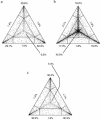Analysis of the serotype and genotype correlation of VP1 and the 5' noncoding region in an epidemiological survey of the human enterovirus B species
- PMID: 15004039
- PMCID: PMC356875
- DOI: 10.1128/JCM.42.3.963-971.2004
Analysis of the serotype and genotype correlation of VP1 and the 5' noncoding region in an epidemiological survey of the human enterovirus B species
Abstract
The sequence identity of the enterovirus VP1 gene has been shown to correlate with the serotype concept. Enterovirus molecular typing methods are therefore often based on sequencing of the VP1 genomic region and monophyletic clustering of VP1 sequences of a homologous serotype. For epidemiological surveillance, 342 enterovirus samples obtained from patients with aseptic meningitis in Belgium from 1999 to 2002 were first diagnosed as being enterovirus positive by amplification of the 5' noncoding region (5'NCR) by reverse transcription (RT)-PCR. Subsequently, samples were molecularly typed by RT-nested PCR amplification and sequencing of a portion of the VP1 gene. Phylogenetic analyses were performed to investigate enteroviral evolution and to examine the serotype and genotype correlation of the two genomic regions. Our typing results demonstrated echovirus 30, echovirus 13, echovirus 18, and echovirus 6 to be the most predominant types. Echoviruses 13 and 18 were considered to be emerging human serotypes since 2000 and 2001, respectively, as they had been rarely reported before. Several serotypes existed as multiple genotypes (subtypes) from 1999 to 2002, but genomic differences mainly resided at synonymous sites; these results strongly suggest that the subtypes exhibit similar antigenic properties. Phylogenetic analyses confirmed that VP1 is an adequate region for molecular typing. Serotype-specific clusters are not observed commonly in phylogenetic trees based on the 5'NCR, and the phylogenetic signal in the 5'NCR was found to be particularly low. However, some substructure in the 5'NCR tree made a tentative prediction of the enterovirus type possible and was therefore helpful in PCR strategies for VP1 (e.g., primer choice), provided some background knowledge on the local spectrum of enteroviruses already exists.
Figures




References
-
- Andersson, P., K. Edman, and A. M. Lindberg. 2002. Molecular analysis of the echovirus 18 prototype: evidence of interserotypic recombination with echovirus 9. Virus Res. 85:71-83. - PubMed
-
- Bailly, J.-L., D. Brosson, C. Archimbaud, M. Chambon, C. Henquell, and H. Peigue-Lafeuille. 2002. Genetic diversity of echovirus 30 during a meningitis outbreak, demonstrated by direct molecular typing from cerebrospinal fluid. J. Med. Virol. 68:558-567. - PubMed
-
- Böttner, A., S. Daneschnejad, W. Handrick, V. Schuster, U. G. Liebert, and W. Kiess. 2002. A season of aseptic meningitis in Germany: epidemiologic, clinical and diagnostic aspects. Pediatr. Infect. Dis. J. 21:1126-1132. - PubMed
-
- Caro, V., S. Guillot, F. Delpeyroux, and R. Crainic. 2001. Molecular strategy for ′serotyping' of human enteroviruses. J. Gen. Virol. 82:79-91. - PubMed
-
- Casas, I., G. F. Palacios, G. Trallero, D. Cisterna, M. C. Freire, and A. Tenorio. 2001. Molecular characterization of human enteroviruses in clinical samples: comparison between VP2, VP1, and RNA polymerase regions using RT nested PCR assays and direct sequencing of products. J. Med. Virol. 65:138-148. - PubMed
Publication types
MeSH terms
Substances
LinkOut - more resources
Full Text Sources
Other Literature Sources

